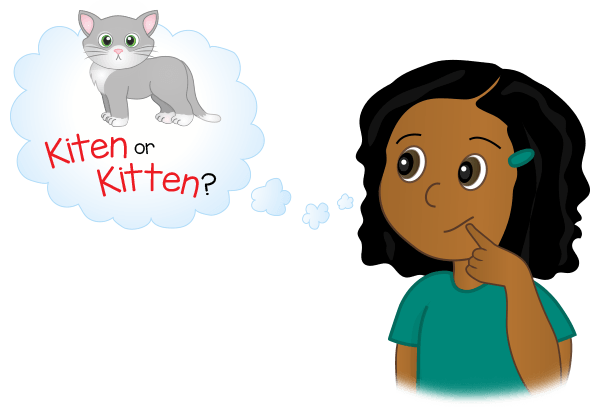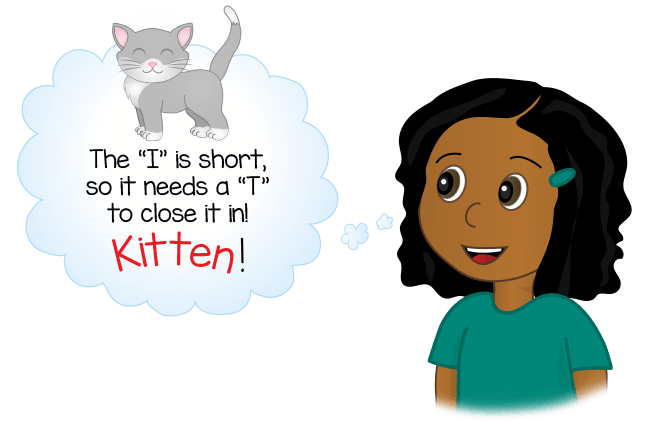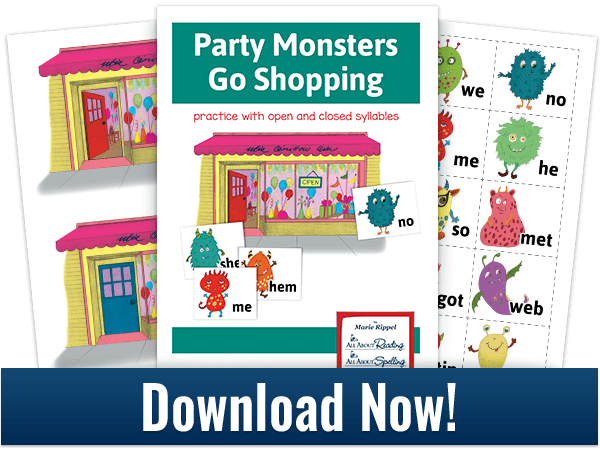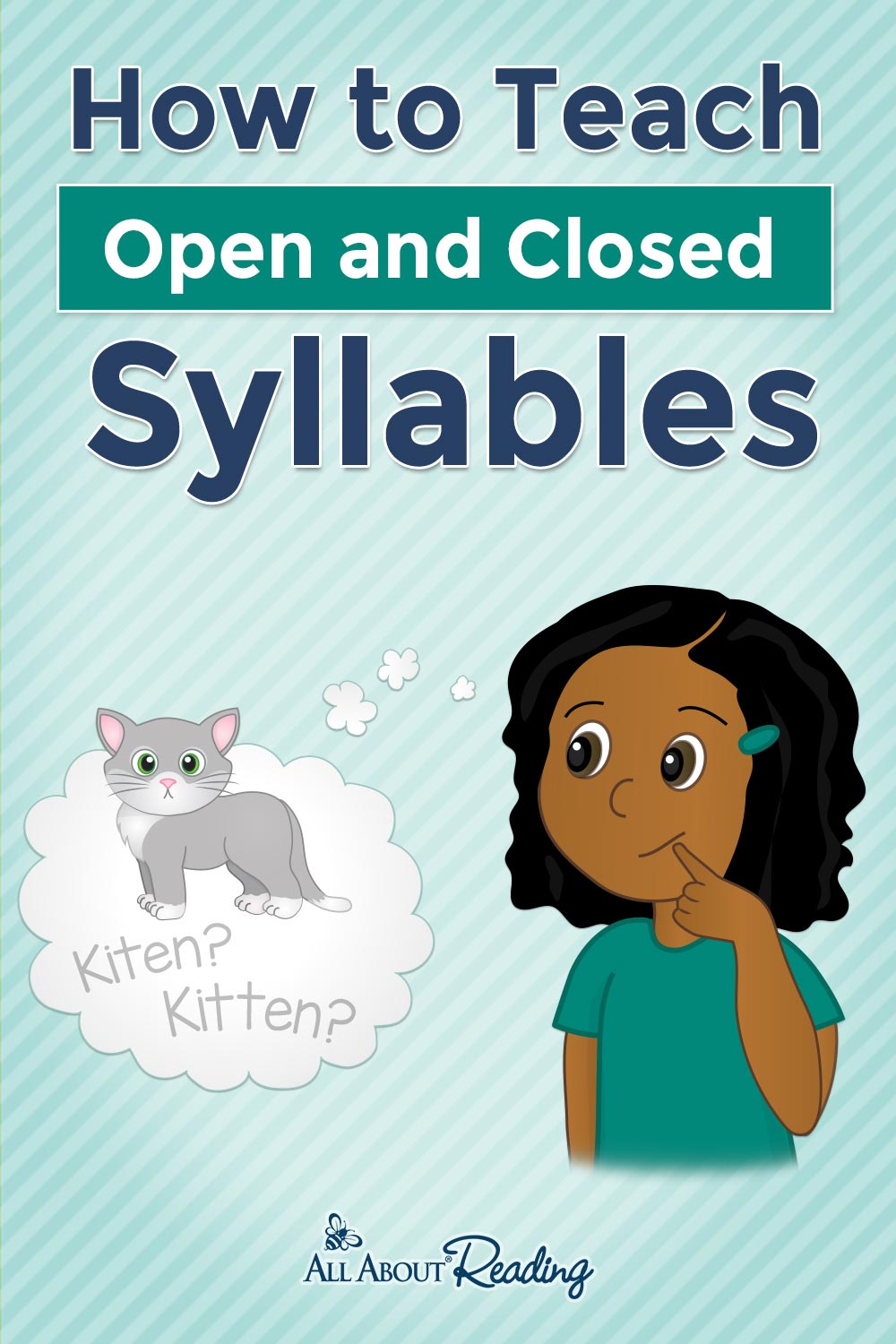How to Teach Open and Closed Syllables
Closed and open syllables are the first two syllable types students should learn. Out of the six syllable types, these two are the easiest for students to master.
What Is a Closed Syllable?
In its simplest form, a closed syllable is a vowel followed by a consonant. Examples include cap, sit, and up.

It’s called a closed syllable because the vowel is “closed in” by a consonant. In closed syllables, the vowel usually says its short sound.
More than one consonant can be used to close in a syllable, as in dish and stretch. And many multisyllable words contain closed syllables, as in insect, rabbit, and napkin.
What Is an Open Syllable?
An open syllable has a vowel at the end of the syllable. Nothing comes after the vowel, as in no, my, and we.

It’s called an open syllable because the vowel is “open”—that is, nothing comes after it except open space. In open syllables, the vowel says its long sound.
There aren’t many one-syllable words that contain open syllables, but there are many multisyllable words that do. For example, look at the first syllables in these words:
ba by
e ven
pa per
mu sic
Why Is Knowing the Syllable Types So Beneficial?
Knowledge of syllable types is an important decoding tool for both reading and spelling.
Let’s say a student is reading a story and she comes across the word craft. She doesn’t instantly recognize the word because she has never read it before. Although the word is unfamiliar, she isn’t flustered because she has a method for determining whether the letter A says its long or short sound. She sees that the A is followed by a consonant, which means that it is in a closed syllable, so the vowel most likely says its short sound. She is able to decode the word craft independently and continues reading the story.
Syllable type knowledge helps with spelling, too. In the scenario below, the child wants to spell the word kitten. But she hasn’t reached the stage of automaticity yet, so she can’t remember whether there is one T or two in the middle of the word.

A child who doesn’t have a visual picture of the word and doesn’t know about syllable types might just write the word as kiten. After all, we pronounce it “ki(t) ten,” without enunciating the first T.
But our student can draw upon her knowledge of open and closed syllable types and easily come up with the correct spelling.

Our student realizes that if she leaves the first vowel open, it will say its long sound, resulting in /kī-těn/. (There are some exceptions such as city where the vowel is left open yet still says its short sound, but these words are the exception rather than the rule. And in the All About Spelling program, we give kids tools to help them spell these exceptions.)
Teaching Open and Closed Syllables
In the All About Reading and All About Spelling programs, we use the letter tiles app (or the physical letter tiles) to demonstrate the differences between open and closed syllables (and all syllable types!). Syllable tags are placed above words, making this a concrete activity. An open door represents an open syllable, and a closed door represents a closed syllable.

In the All About Reading program, fun characters known as Party Monsters pitch in to give kids even more practice with open and closed syllables. Give it a try with this free download!

Knowing just these two types of syllables will enable your student to accurately spell hundreds of words!
For even more great samples, feel free to visit our Reading and Spelling Lesson Samples page. You’ll find hundreds of pages of downloadable PDFs that are packed with information.
Do you have questions about open and closed syllable types? Ask in the comments below or get in touch! We’re here to help.











Barbara Johnson
says:Great graphics and clearly explained!
Robin
says: Customer ServiceThank you, Barbara!
Kathy Graham
says:Great Examples!
Robin
says: Customer ServiceThank you, Kathy!
anthony
says:is crash a syllable
Robin
says: Customer ServiceAnthony,
Yes, crash is a one-syllable word. It is a closed syllable, because there are consonants after the vowel, closing it in.
Carolyn Wheale
says:How do you explain the word climb. Is it an exception to the closed syllable rule since the i has a long sound?r
Robin
says: Customer ServiceGreat question, Carolyn!
What you are seeing with the word climb is an English rule at play, the Find Gold Rule. The vowels I and O can say their long sounds when followed by two consonants, such as the words find, gold, wild, bolt, pint, most, and many more. However, note that this is a “can” rule. There are words with I or O followed by two consonants that say their short vowel sound, such as quilt, pond, wind (the wind blows through the trees), doll, etc.
We don’t have a blog post specifically about the Find Gold Rule, but it is included in our blog post on A Handy Guide to Long Vowel Sounds.
I hope this clears things up!
Dorothy Akongo
says:This was a very wonderful idea put together
Robin
says: Customer ServiceThank you, Dorothy!
Cindy
says:Thank you for the free download resource – super helpful!
Robin
says: Customer ServiceYou’re welcome, Cindy! I’m glad this will be helpful!
Arlene
says:I didn’t know this! I’m considering using this program.
Robin
says: Customer ServiceArlene,
Glad we could help you learn something!
Let me know what questions you have. I’m happy to help!
Tech . Sana'a
says:The simplest way actually to understand . Thank you so much 👍
Robin
says: Customer ServiceYou’re welcome!
Zyanna
says:It was so good today
Robin
says: Customer ServiceWonderful to hear, Zyanna!
enid
says:What about “do” and “to”? Why are they not pronounced like “go”?
Robin
says: Customer ServiceGood question, Enid.
Do and to both use the third sound of O, the /oo/ sound. The reason why they are pronounced this way and spelled this way is because they are very old words. Both have roots in Old English (prior to the 1000s AD/CE) and have existed with pretty much the same meaning and pronunciations since Middle English (prior to the 1500s AD/CE).
JC
says:In the “kitten” example above, I see how she figures out that she needs a “t” to close in the short “i”, but… how does she know she needs the second “t”? In other words, how does she know it’s “kit-ten” and not “kit-en”?
Robin
says: Customer ServiceGood question!
The rule is when a word is divided and there is only one consonant between two vowels, the consonant usually goes with the second vowel. So kiten would be divided ki-ten. This would make the first syllable open, so the I would say it’s long sound, making the word sound like ky-ten. That is not what the word needs to sound like, so we know we need to “protect the short vowel” and double the T. Kitten.
The explanation here is brief simply due to space. All About Spelling Level 2 spends multiple lessons on spelling words like kitten and robot and how to know when to double the middle consonant and when not to. While a tricky concept, All About Spelling approach and ongoing review helps children master such words with confidence!
JC
says:Thank you! That clears it up. : )
Blanca Garcia
says:Omg, I am Spanish speaker, and I am looking how to help my second grade child and this explanation was the best. Thank you so much!
Robin
says: Customer ServiceI’m glad this was helpful, Blanca! If you have other questions, just ask. We’re happy to help!
Eve
says:Extremely easy to understand
Robin
says: Customer ServiceThanks, Eve!
Mervelin
says:This makes teaching how to spell and read to kids so much easier!
Robin
says: Customer ServiceThank you, Mervelin!
Stephanie
says:Is tail an open or closed syllable? Why/why not?
Robin
says: Customer ServiceGood question, Stephanie.
Tail is not an open syllable type, and it is not a closed syllable type either. Open and closed syllables are just two of the six syllable types. Tail is a vowel team syllable, referring to the fact that it contains a vowel team phonogram. This page briefly goes over the various syllable types.
Brenda Baker
says:Just what I’m looking for
Robin
says: Customer ServiceBrenda,
I’m glad this was what you needed! But if you ever are looking for anything else, let me know. I’m happy to help!
Edward s.korvah
says:Thank you somuch. I am learning alot.l need more help,and what ever i am learning from you i will teach it in my class.
Robin
says: Customer ServiceI’m happy to help with any questions you may have, Edward. Just ask.
Taylor McCown
says:hi thank you
Robin
says: Customer ServiceYou’re welcome, Taylor.
Lana Johnson
says:Thank you
Robin
says: Customer ServiceYou’re welcome, Lana.
Cathy McCutchen
says:Great way to teach the kids about life by and short vowels!!! Wish they had been taught this method in K!
Robin
says: Customer ServiceThank you, Cathy!
Mona
says:Does the word baker open or closed syllables
Robin
says: Customer ServiceGood question, Mona.
To divide this word into syllables, you locate the vowels and then divide so the consonant between them goes with the second syllable. So the word divides to:
ba – ker
Then we can see the first syllable is an open syllable. There is no consonant closing in the first vowel, so it is open. It says it’s long sound.
The second syllable, however, is neither open nor closed. It is a Bossy R (or R-Controlled) syllable. Syllables that have AR, ER, IR, OR, UR, EAR, and OUR phonograms are Bossy R syllables.
Open and closed syllables are just the first two of six syllable types. Here is a handy PDF that lists the six syllable types.
I hope this clears it up for you. Let me know if you have additional questions.
Angela
says:I have seem to have lost (misplaced!!) our syllable tags – I am upset because they were laminated…
curious if there is a download of the pictures that I could just print? Thank you
Robin
says: Customer ServiceAngela,
We will happily replace 5 or so missing tiles, free of charge. If you email us at support@allaboutlearningpress.com with what tiles you need and where you need them shipped, we will get them out to you.
And if you are missing much more than 5, we do have things like the Syllable Tags available for purchase separately.
Clarissa Mercer
says:Thank you so much for this explanation, I am a substitute teacher and will be teaching this method ti 1st graders tomorrow, I think this is an explanation they can understand.
Kweku
says:Great job
Robin
says: Customer ServiceYou’re so welcome, Clarissa!
Cathy Rollinson Claude
says:I would like to here more on reading and spelling
Bonnie
says:Such a great explanation! Thx
Robin
says: Customer ServiceThank you, Bonnie!
Andrew Greene
says:There are two words in a list I am working on with students (sign and climb) that appear to be closed syllables, but have long vowel sounds. I looked up closed syllable exceptions and found that there are five agreed upon exceptions (–ild, –ind, –old, –olt, and –ost). A fun sentence to demonstrate these exceptions is: The cold host was kind to the wild colt.
I understand that –ild, –ind, –old, –olt, and –ost are closed syllable exceptions, but what about –ign in “sign” or –imb in “climb”? Wouldn’t these also be closed syllable exceptions? Or is there something about the silent letters that makes these a different type of exception or rule-breaker?
Robin
says: Customer ServiceAndrew,
All About Reading and All About Spelling teach the “Find Gold” rule. This rule says that I and O followed by two consonants may say their long sounds. This is what is happening in sign and climb.
I think you will find our A Handy Guide to Long Vowel Sounds blog post helpful. It includes an activity for the Find Gold rule.
Meagan Marazzo
says:We just finished our first book Level 2 All About Spelling. Understanding open and closed syllables has greatly improved my sons spelling and reading! I am excited to start Level 3!
Robin E.
says: Customer ServiceGreat to hear, Meagan! Understanding the various types of syllables is so helpful for so many students. Keep up the fantastic work!
Thelma
says:Pls I need more explanation on syllables and stress
Robin E.
says: Customer ServiceThelma,
We have a blog post on How to Teach Schwas that you may find helpful. It discusses stressed and unstressed syllables.
If that is not what you need, I am happy to help, but I would need more information on what it is you having difficulty understanding.
Sharon Feissel
says:Hello. I understand what open syllables are and that vowels should have the long sound in stressed syllables and the schwa in unstressed syllables. However, it seems to me that there are a lot of words where the vowel in the open syllable has its short sound. Is there any place to look up info on that particular situation? I also think that even unstressed syllables often keep the long vowel sound. I would like to help my daughter as she helps my grandson with learning. I find the open syllable really challenging to get a handle on. Any clarification would be deeply appreciated–or info on some trustworthy online explanation that I could look up myself.
Thanks, Sharon Feissel
Robin E.
says: Customer ServiceI am happy to help, but I am unsure what it is you need exactly, Sharon. Could you provide me an example of a vowel in an open and stressed syllable that does not say the long sound?
When you get to complex words with three or more syllables, vowel sounds can definitely be trickier. A significant focus of our All About Reading Level 4 program is on practicing the skills necessary for students to be able to sound out such words without help. Level 4 is the final level of the reading program, and at the end of Level 4, students have the phonics and word attack skills necessary to sound out high school level words, though younger students may not know the meaning of all higher-level words yet. (Word attack skills include things like dividing words into syllables, making analogies to other words, sounding out the word with the accent on different word parts, recognizing affixes, etc.)
Yes, unstressed syllables can have long vowel sounds, although they will be more muffled or hurried compared to the same sound in stressed syllables.
I would love to help you further, but I would need more examples of the kind of words you are having trouble with. One-syllable words with open syllables are very straightforward (go, by, me, cry). Two-syllable words with open syllables also tend to not be problematic (robot, humid, baby). Things get more complex with words with three or more syllables, but still, syllable division rules do help greatly to know how to read the word (destruction, emission, January, octopus).
Natasha
says:We are starting this program at level 2 based on the placement test. However, we have never talked about open and closed syllables. What is the best way to teach this so we can successfully move forward?
Robin E.
says: Customer ServiceNatasha,
Open and closed syllables are just introduced at the end of All About Reading Level 1, and it is also reviewed pretty well in the first lesson of Level 2. You could use the Party Monsters Go Shopping activity in this blog post to have a fun introduction to the concept, and then practice it again when you start Level 2. It’ll be fine.
Mariah Cooke says:
says:hi i’m new to this website can you please give me open and closed syllables?
Grace Churcùhill
says:Hi great. Just knowing this for the first time.
Robin E.
says: Customer ServiceMariah,
Do you have specific questions? This blog post above has detailed help on the concepts of open and closed syllables, including examples of each.
Mariah Cooke
says:I need help with open and closed syllables.